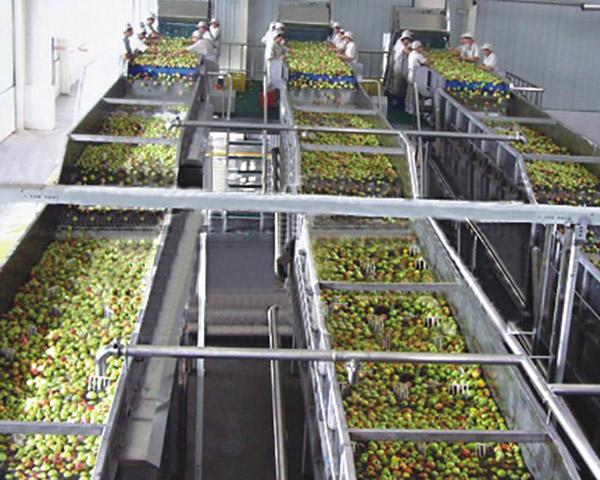Stainless steel automatic apple juice production line proces
Time:2021-04-07 15:24 Browse:277
Apple juice production line
Fruit and vegetable juice contains a lot of water, sugar, malic acid, citric acid, tartaric acid, etc. fruit juice also contains a small amount of tannin and protein. Minerals mainly include calcium, phosphorus, potassium, sodium, etc. Pigments include carotenoids and anthocyanins. It also contains a small amount of temperature sensitive substances and aromatic substances. Only by fully mastering the composition and characteristics of fruit and vegetable juice, can we flexibly apply various technologies in the processing and production of fruit juice, intervene in the links that destroy the original nutrition, color, flavor and aroma of fruit juice, and obtain high-quality original flavor products to a large extent.
Fruit juice is generally divided into clarified juice and turbid fruit and vegetable juice. Common clarified juice includes apple juice, pear juice, grape juice, melon juice, blueberry juice, blackberry juice, etc.; turbid fruit and vegetable juice includes orange juice, tomato juice, fresh carrot juice, etc.; pulp juice generally includes peach, apricot, plum, plum, etc. Juice processing technology: pretreatment (selection, cleaning, crushing, heat treatment). Juice extraction - coarse filtration - composition adjustment - fine filtration - homogenization
In the pretreatment process, it should be noted that fruits and vegetables with more pesticide residues can be treated with dilute hydrochloric acid or fatty acid when cleaning. For microbial pollution, they can be soaked in a certain concentration of bleaching powder or solution, and then cleaned with water. After most fruits are broken, they must be preheated before juicing to soften the pulp tissue and improve the yield of juice. In addition, different preheating temperatures can promote or inhibit the activity of enzymes. According to the properties of enzymes, the appropriate pH value, temperature and action time directly affect the color and flavor of products. Therefore, different processing technologies must be mastered according to different market demands. The methods of juice clarification include enzyme method, gelatin tannin method, enzyme gelatin method, diatomite method and so on. It should be noted that the suitable pH value for pectinase treatment is 4.5 ≤ 5.0 and the temperature is 50 ℃. In the case of grape juice processing, special tar removal should be carried out.
Adjust and mix the juice, that is, the blending process. Including sugar regulation, determination of solid acid ratio, vitamin C addition and so on. To make the product reach a certain specification is a decisive step for the nutrition, taste and color of the product. In the production of turbid juice, it is also necessary to homogenize the juice to prevent solid-liquid separation and stratification, and promote more delicate taste. In order to prevent the oxidation and deterioration of fruit juice, it is necessary to degass the fruit juice in the process of pretreatment to remove a lot of oxygen, carbon dioxide and nitrogen. Juice concentration generally adopts falling film concentration, which needs low temperature, rapid concentration under vacuum. Under these conditions, the concentration tank can achieve great energy saving effect, thus reducing the production cost. In the process of concentration, it is usually necessary to recover the juice. The aromatic recovery of apple juice was 8% ≤ 10%, and that of grape juice and orange juice was 26% ≤ 30%.
The clarified juice is mainly hot filled and sterilized by tunnel after filling, usually at 85 ℃ ~ 95 ℃ for 15 ~ 30 min. For turbid fruit juice, high temperature and short time sterilization are generally used, because turbid fruit juice is easy to overheat due to long heating time, and the loss of color and flavor is relatively large. After sterilization, it cools quickly and then carries out subsequent packaging.


